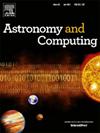Morphological classification of eclipsing binary stars using computer vision methods
IF 1.8
4区 物理与天体物理
Q2 ASTRONOMY & ASTROPHYSICS
引用次数: 0
Abstract
We present an application of computer vision methods to classify the light curves of eclipsing binaries (EB). We have used pre-trained models based on convolutional neural networks (ResNet50) and vision transformers (vit_base_patch16_224), which were fine-tuned on images created from synthetic datasets. To improve model generalisation and reduce overfitting, we developed a novel image representation by transforming phase-folded light curves into polar coordinates combined with hexbin visualisation. Our hierarchical approach in the first stage classifies systems into detached and overcontact types, and in the second stage identifies the presence or absence of spots. The binary classification models achieved high accuracy () on validation data across multiple passbands (Gaia , , and ) and demonstrated strong performance (, up to 100% for ) when tested on extensive observational data from the OGLE, DEBCat, and WUMaCat catalogues. While the primary binary classification was highly successful, the secondary task of automated spot detection performed poorly, revealing a significant limitation of our models for identifying subtle photometric features. This study highlights the potential of computer vision for EB morphological classification in large-scale surveys, but underscores the need for further research into robust, automated spot detection.
用计算机视觉方法对食双星进行形态分类
提出了一种应用计算机视觉方法对食双星(EB)光曲线进行分类的方法。我们使用了基于卷积神经网络(ResNet50)和视觉转换器(vit_base_patch16_224)的预训练模型,这些模型对从合成数据集创建的图像进行了微调。为了提高模型的泛化和减少过拟合,我们开发了一种新的图像表示方法,将相位折叠光曲线转换为极坐标并结合hexbin可视化。我们的分层方法在第一阶段将系统分为分离和过度接触类型,在第二阶段确定斑点的存在或不存在。二元分类模型在多个波段(Gaia G、I和TESS)的验证数据上获得了很高的准确率(>96%),并且在OGLE、DEBCat和WUMaCat目录的大量观测数据上进行测试时表现出了很强的性能(>94%, TESS高达100%)。虽然主要的二元分类非常成功,但自动斑点检测的次要任务表现不佳,这揭示了我们的模型在识别细微光度特征方面的显着局限性。这项研究强调了计算机视觉在大规模调查中EB形态分类的潜力,但强调了对鲁棒、自动化斑点检测的进一步研究的必要性。
本文章由计算机程序翻译,如有差异,请以英文原文为准。
求助全文
约1分钟内获得全文
求助全文
来源期刊

Astronomy and Computing
ASTRONOMY & ASTROPHYSICSCOMPUTER SCIENCE,-COMPUTER SCIENCE, INTERDISCIPLINARY APPLICATIONS
CiteScore
4.10
自引率
8.00%
发文量
67
期刊介绍:
Astronomy and Computing is a peer-reviewed journal that focuses on the broad area between astronomy, computer science and information technology. The journal aims to publish the work of scientists and (software) engineers in all aspects of astronomical computing, including the collection, analysis, reduction, visualisation, preservation and dissemination of data, and the development of astronomical software and simulations. The journal covers applications for academic computer science techniques to astronomy, as well as novel applications of information technologies within astronomy.
 求助内容:
求助内容: 应助结果提醒方式:
应助结果提醒方式:


